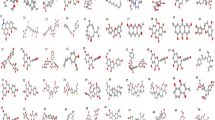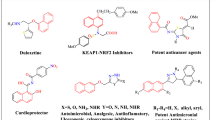Abstract
Aurora kinases are the cell cycle mitotic regulators processing multiple functions during cell division. Altered mechanism of these mitotic kinases may contribute to genomic instability that is most often correlated with tumorigenesis, which has been reported in many human cancers. Selective blockage of the aberrantly expressed Aurora kinases has the potential therapeutic assessment to control the deregulated cell cycle machinery and their associated risks of cancer. Using a combination of docking-, ligand- and structure-based pharmacophore strategies, in the present study, we have tried to predict the anticancer potentiality of our synthesized compounds (A1 to A5 and B1 to B9) against human Aurora B kinase. The results revealed that among all the compounds, compound B7 may act as a best candidate to be an agent of the high binding affinity with a score of 113.464 kcal/mol and good pharmacophoric features with acceptable fit values of both ligand- and structure-based pharmacophore models. Consequently, ADMET properties are also calculated to predict the safer efficacy of the compounds.







Similar content being viewed by others
References
Ferlay J, Soerjomataram I, Ervik M, Dikshit R, Eser S, Mathers C, Rebelo M, Parkin DM, Forman D, Bray F( (2013) GLOBOCAN 2012 v1.0 cancer incidence and mortality worldwide: IARC CancerBase No. 11. International Agency for Research on Cancer, Lyon
Dikmen M, Ozturk N, Ozturk Y (2011) The antioxidant potency of Punica granatum L. fruit peel reduces cell proliferation and induces apoptosis on breast cancer. J Med Food 14:1638–1646
Shen Z (2011) Genomic instability and cancer: an introduction. J Mol Cell Biol 3(1):1–3
Negrini S, Gorgoulis VG, Halazonetis TD (2010) Genomic instability-an evolving hallmark of cancer. Nat Rev Mol Cell Biol 11:220–228
Failes TW, Mitic G, Abdel-Halim H, Po’uha ST, Liu M, Hibbs DE, Kavallaris M (2012) Evolution of resistance to Aurora Kinase B inhibitors in leukaemia cells. PLoS ONE 7(2):30734
Bayliss R, Fry A, Haq T, Yeoh S (2012) On the molecular mechanisms of mitotic kinase activation. Open Biol 2:120136
Jayanthan A, Ruan Y, Truong TH, Narendran A (2014) Aurora Kinases as druggable targets in pediatric leukemia: heterogeneity in target modulation activities and cytotoxicity by diverse novel therapeutic agents. PLoS ONE 9(7):102741
Brognard J, Hunter T (2011) Protein kinase signaling networks in cancer. Curr Opin Genet Dev 21:4–11
Chan KS, Koh CG, Li HY (2012) Mitosis-targeted anti-cancer therapies: where they stand. Cell Death Dis 3(10):411
Lin ZZ, Chou CH, Cheng AL, Liu WL, Chia-Hsien Cheng J (2014) Radiosensitization by combining an aurora kinase inhibitor with radiotherapy in hepatocellular carcinoma through cell cycle interruption. Int J Cancer 135:492–501
Hochegger H, He´garat N, Pereira-Leal JB (2013) Aurora at the pole and equator: overlapping functions of Aurora kinases in the mitotic spindle. Open Biol 3:120185
Dar AA, Goff LW, Majid S, Berlin J, El-Rifai W (2010) Aurora kinase inhibitors–rising stars in cancer therapeutics? Mol Cancer Ther 9:268–278
Lens SMA, Voest EE, Medema RH (2010) Shared and separate functions of polo-like kinases and aurora kinases in cancer. Nat Rev Cancer 10:825–841
Kamaraj B, Kumar A, Purohit R (2013) Evolutionary reconstruction and population genetics analysis of aurora kinases. PLoS ONE 8(9):757–763
Nikonova AS, Astsaturov I, Serebriiskii IG, Dunbrack RL, Golemis EA (2013) Aurora-A kinase (AURKA) in normal and pathological cell growth. Cell Mol Life Sci 70(4):661–687
Carmena M, Wheelock M, Funabiki H, Earnshaw WC (2012) The chromosomal passenger complex (CPC): from easy rider to the godfather of mitosis. Nat Rev Mol Cell Biol 13:789–803
Vander Waal MS, Hengeveld RC, Vander Horst A, Lens SM (2012) Cell division control by the chromosomal passenger complex. Exp Cell Res 318(12):1407–1420
Neaz MM, Muddassar M, Pasha FA, Cho SJ (2010) Structural studies of B-type Aurora kinase inhibitors using computational methods. Acta Pharmacol Sin 31(2):244–258
Avo Santos M, van de Werken C, de Vries M, Jahr H, Vromans MJ, Laven JS, Fauser BC, Kops GJ, Lens SM, Baart EB (2011) A role for Aurora C in the chromosomal passenger complex during human preimplantation embryo development. Hum Reprod 26:1868–1881
Linardopoulos S, Blagg J (2015) Aurora Kinase inhibition: a new light in the sky? J Med Chem 58(13):5186–5188
Mehra R, Serebriiskii IG, Burtness B, Astsaturov I, Golemis EA (2013) The role and targeting of Aurora kinases in head and neck cancer. Lancet Oncol 14(10):e425–e435
Moore AS, Blagg J, Linardopoulos S, Pearson ADJ (2010) Aurora kinase inhibitors: novel small molecules with promising activity in acute myeloid and Philadelphia-positive leukemias. Leukemia 24:671–678
Lucena-Araujo AR, de Oliveira FM, Leite-Cueva SD, dos Santos GA, Falcao RP, Rego EM (2011) High expression of AURKA and AURKB is associated with unfavorable cytogenetic abnormalities and high white blood cell count in patients with acute myeloid leukemia. Leuk Res 35:260–264
Lampson MA, Cheeseman IM (2011) Sensing centromere tension: aurora B and the regulation of kinetochore function. Trends Cell Biol 21(3):133–140
Katayama H, Sen S (2010) Aurora kinase inhibitors as anticancer molecules. Biochim Biophys Acta 1799:829–839
An Ying, Lee Eun, Yeongji Yu, Yun Jieun, Lee Myeong Youl, Kang Jong Soon, Kim Woo-Young, Jeon Raok (2016) Design and synthesis of novel benzoxazole analogs as Aurora B kinase inhibitors. Bioorg Med Chem Lett 26(13):3067–3072
Batool S, Ferdous S, Kamal MA, Iftikhar H, Rashid S (2013) In silico screening for identification of novel Aurora Kinase inhibitors by molecular docking, dynamics simulations and ligand-based hypothesis approaches. Enzyme Eng 2:106
Karthigeyan D, Surabhi S, Mizar P, Soumik S, Banerjee A, Sinha SH, Dasgupta D, Narayana C, Kundu TK (2016) A dual non-ATP analogue inhibitor of Aurora Kinases A and B, derived from resorcinol with a mixed mode of inhibition. Chem Biol Drug Des 87:958–967
Petsalaki Eleni, Zachos George (2016) Clks 1,2 and 4 prevent chromatin breakage by regulating the Aurora B-dependent abscission checkpoint. Nat Commun 7:11451
Sasai K, Katayama H, Hawke DH, Sen S (2015) Aurora-C interactions with Survivin and INCENP Reveal shared and distinct features compared with Aurora B chromosome passenger protein complex. PLoSONE 11(6):e0157305
Kumar A, Purohit R (2014) Use of long term molecular dynamics simulation in predicting cancer associated SNPs. PLoS Comput Biol 10(4):E1003318
Acknowledgements
We would like to thank Dr. Sarangapani, Principal of Kakatiya University, for the support of this work.
Author information
Authors and Affiliations
Corresponding author
Ethics declarations
Conflict of interest
The authors confirm that this article content has no conflict of interest.
Rights and permissions
About this article
Cite this article
Vadlakonda, R., Nerella, R. & Enaganti, S. Theoretical Studies on Azaindoles as Human Aurora B Kinase Inhibitors: Docking, Pharmacophore and ADMET Studies. Interdiscip Sci Comput Life Sci 10, 486–499 (2018). https://doi.org/10.1007/s12539-016-0205-4
Received:
Revised:
Accepted:
Published:
Issue Date:
DOI: https://doi.org/10.1007/s12539-016-0205-4




